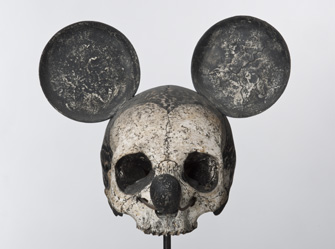 |
|
Paul Cézanne’s “Nature Morte, Crâne et Chandelier” |
We probably have Damien Hirst to thank (or blame, depending on your point of view) for the current craze for vanities, those skeletal …
 |
|
Paul Cézanne’s “Nature Morte, Crâne et Chandelier” |
We probably have Damien Hirst to thank (or blame, depending on your point of view) for the current craze for vanities, those skeletal representations of humans that have been around since Antiquity in the form of momenti mori to remind us that our days are numbered. Hirst, who knows how to work the media and profit from it like few other contemporary artists, has been doing skulls for some time. He made the skull to top all skulls – a diamond-encrusted platinum cast of a real human cranium with an asking price of £50 million – in 2007.
We don’t get to see that gem in the Musée Maillol’s new show, “That’s Life: Vanities from Caravaggio to Damien Hirst,” but we do get to see a diamond-dusted silkscreened depiction of it in this sweeping panorama of works on the subject, which range from horrifying to humorous. Two of Hirst’s highly effective real skulls encrusted with real flies are also on show.
The exhibition even includes a Caravaggio, “Saint Francis in Prayer,” which, unfortunately, is not one of the master’s most forceful works (apparently there is some doubt about its attribution to the master). More striking is
 |
|
Francisco de Zurbara: “San Francisco Arrodillado” (c. 1635). © Collection Adolfo Nobili, Milan |
Francisco de Zurbaran’s painting of the kneeling saint contemplating a brightly lit skull from the shadows of his pointed cowl.
In between, we have skulls and skeletons depicted in every imaginable style and medium and from just about every era. Cezanne weighs in with a painted still life of a skull and candlestick. Jacopo Ligozzi’s 17th-century oil painting “Testa Mozzata su Libro” shows a decaying head sitting on a book, with the inscription “seneta” (old age), but it is certainly not the most grotesque piece in the show. Other contenders would have to be two wonderfully warped sculptures by brothers Jake and Dinos Chapman. One of them, “Migraine,” is of a skull with vampire teeth and lolling tongue, crawling with worms and flies.
Annette Messager offers a soft sculpture of a skull made violently prickly with sharpened pencils, while Philippe Pasqua perches lavish open-winged butterflies on a real skull. In a 17th-century painting by Luigi Miradori, a chubby Cupid sleeps peacefully, his head resting on a skull with a scarily gaping
 |
|
Nicolas Rubinstein: “Untitled” (2006). © Jean-Alex Brunelle |
jaw. Daniel Spoerri hangs a real human skeleton and a rifle on a kitschy mass-manufactured wall hanging showing noble lions in the wild staring haughtily over their victim in “The Lioness and the Hunter” (1988).
A series of vitrines shows off the wildly elaborate momento mori jewelry that has been produced since 1866 by the Venitian company Codognato, which has counted among its customers Edouard Manet, Serge Diaghilev, Jean Cocteau, Luchino Visconti, Andy Warhol and Elton John.
The list of artists on show goes on and on: Keith Haring, Jean-Michel Basquiat, Andy Warhol, Niki de Saint Phalle, Robert Mapplethorpe, Marc Quinn, Douglas Gordon, Pierre et Gilles, Cindy Sherman, Yan Pei-Ming and many more. Don’t miss this entertaining tour around human mortality in art through the ages.
Musée Maillol: 61, rue de Grenelle, 75007 Paris. Métro: Rue de Bac. Tel.: 01 42 22 59 58. Open Wednesday-Monday, 10:30am-7pm (until 9:30pm on Friday). Admission: €11. Through June 28. www.museemaillol.com
More reviews of Paris art shows.
Reader Reaction: Click here to respond to this article (your response may be published on this page and is subject to editing).
© 2010 Paris Update
Favorite